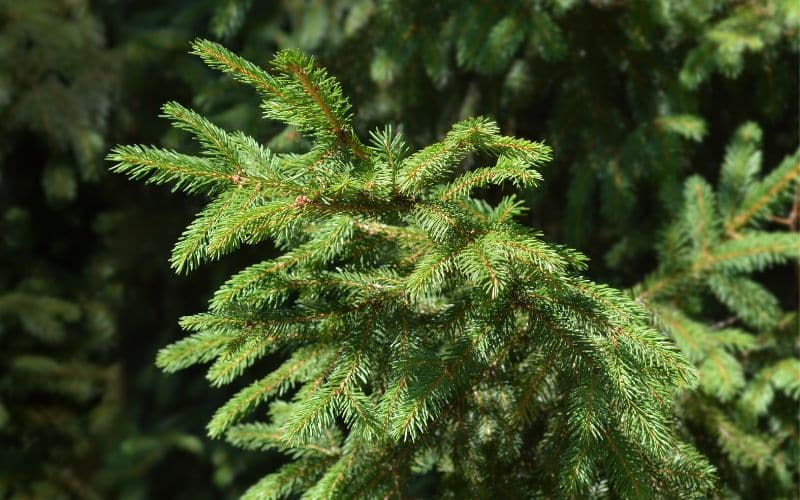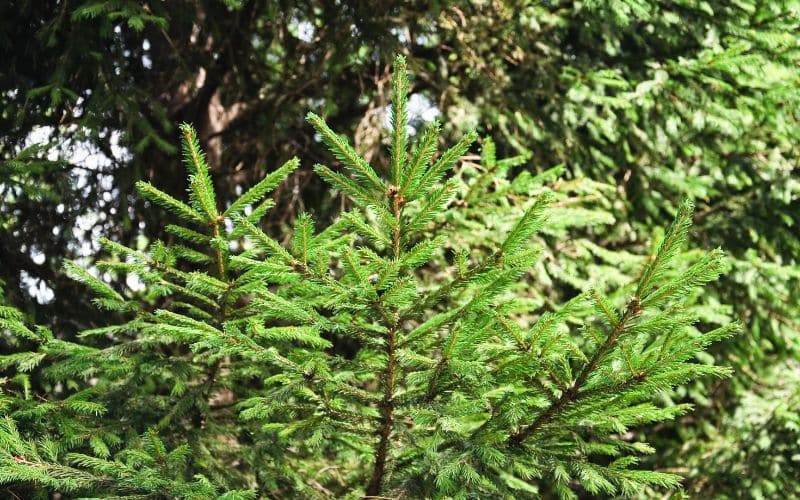
Norway Spruce, a towering beauty native to Northern Europe, has found its home also in Ontario’s diverse landscapes. You’re probably familiar with this evergreen – it’s the traditional Christmas tree in many homes around the world. But there’s more to the Norway Spruce than just holiday cheer.
In Ontario, these trees play an essential role in maintaining healthy ecosystems and providing valuable resources for both wildlife and people alike. From birds nesting high up amongst its dense branches to humans utilising its timber for construction, Norway spruces are a testament to nature’s versatility.
Their impressive height (they can grow up to 60 metres tall), rapid growth rate and resilience make them an attractive choice for commercial forestry as well as private gardening endeavours across Ontario. Whether you’re considering planting one in your backyard or simply fascinated by their majestic presence, understanding Norway Spruces will deepen your appreciation of these wonderful trees.
Understanding the Norway Spruce in Ontario
You’ve likely seen the majestic Norway Spruce dotting landscapes across Ontario, but have you ever stopped to really consider this remarkable tree? Let’s take a moment to delve deeper into understanding this native of Europe that has become so popular in our Canadian province.
First off, it’s important to know that Picea abies or more commonly known as the Norway Spruce is not originally from Canada. In fact, it hails from Northern and Central Europe. But don’t let its foreign origins fool you – over time, this spruce has made itself right at home here in Ontario.
This species of spruce can grow up to 35 metres tall with a trunk diameter spanning around 1 metre. It sports dark green needles and produces lovely red-brown cones which add an aesthetic appeal while serving an important ecological role too! These trees are also hardy survivors capable of living for hundreds of years – some even surpassing a thousand!
| Height Range (metres) | Trunk Diameter (metres) |
|---|---|
| Up to 35m | Around 1m |
In addition to their physical attributes, what makes these trees particularly special is their versatility:
- They’re often used as Christmas Trees due their dense foliage.
- Their timber proves invaluable for construction and furniture-making industries.
- They act as windbreaks on farms protecting crops from damaging winds.
What’s more interesting about these magnificent trees? Well they serve not only humans but wildlife too! Birds find refuge amongst its branches while small mammals benefit from seeds contained within those eye-catching cones we mentioned earlier.
So next time you come across a towering Norway Spruce remember – there’s much more than meets the eye with these incredible trees!

Growth and Maintenance of Your Norway Spruce
If you’re a fan of evergreens, there’s no doubt that you’ll fall in love with the Norway spruce. It’s an attractive tree that is native to Northern Europe but has found its way into many Canadian gardens due to its hardiness and beauty. But how do you ensure your spruce thrives? Let’s delve into some handy tips for growing and maintaining your Norway Spruce.
Firstly, it’s crucial to know where to plant your spruce. These trees favour full sun exposure so pick a spot in your garden that gets plenty of sunlight throughout the day. However, they can tolerate partial shade too! When planting this species, ensure there is ample room as mature trees can reach heights up 20-60 meters with widths stretching between 4-6 meters.
Secondly, don’t forget about soil conditions! The Norway Spruce prefers well-drained soils with acidic pH levels ranging from 4.0 -7.5. Regular testing of the soil will help maintain these optimal conditions for growth.
Now let’s discuss watering routines; while established trees are quite drought tolerant – newly planted saplings require regular watering until they’re firmly rooted in their new home which usually takes around two years.
- Watering once per week should be sufficient during normal weather conditions
- In hotter periods or during prolonged dry spells increase this frequency
Lastly on our list: pruning! While not strictly necessary for health reasons – occasional trimming helps shape younger plants and encourages denser growth patterns:
- Best time to prune is late winter/early spring when the tree remains dormant
- Remove dead branches first before shaping overall structure
By following these guidelines closely – nurturing a vibrant healthy specimen shouldn’t pose much trouble at all!
Remember though: while fairly resistant against pests diseases may still occur particularly if stressors such as drought become prevalent:
- Fungus can cause needle loss: Fungicides may help in early stages of infection
- Spruce spider mites: Tiny red spiders that feed on needles – if noticed use insecticidal soap or horticultural oils
With consistent care and attention, your Norway spruce should flourish and serve as a beautiful focal point in your garden for many years to come.
The Ecological Impact of Norway Spruces in Ontario
Norway Spruce, or Picea abies as it’s scientifically known, has quite a story to tell when it comes to its impact on the ecology of Ontario. This mighty tree species hailing from Northern Europe has made itself at home across the province, influencing both local habitats and wildlife.
Firstly, let’s talk about soil health. The Norway spruce is a nutrient hog – gobbling up water and minerals from the ground like there’s no tomorrow. That might not sound too good for other plant life but here’s an interesting twist: decomposing needles dropped by these trees actually enrich soils with organic matter over time.
| Nutrient | Amount Absorbed by Mature Norway Spruce |
|---|---|
| Nitrogen | 100 kg/ha/year |
| Potassium | 30 kg/ha/year |
Now you’re probably thinking – what about biodiversity? Well, the dense foliage provided by these towering trees offers a haven for numerous bird species such as crossbills and siskins. However:
- Their shade-tolerant nature can overshadow understory plants.
- They are less favourable for native insects compared to indigenous conifers.
In terms of carbon sequestration – our fight against climate change – this is where Norway spruces really come into their own. These hardy giants have got your back! In fact:
- A mature tree can absorb up to 22kg CO2 per year
- A hectare (10k sq metres) of plantation could lock away around 12 tonnes annually
So you see, while they may be foreign guests in Ontario’s landscapes; they’ve certainly earned their keep ecologically speaking! It’s clear that their presence brings along complex impacts that contribute significantly towards shaping our ecosystems’ dynamics.
That being said though, we must always remember balance is key in nature. It’s important to ensure these trees don’t outcompete native species or negatively affect local biodiversity in our drive for greener spaces and climate resilience.
After all, it’s a delicate dance of give-and-take that keeps our ecosystems thriving – the Norway spruce just happens to be one of the dancers!

Common Pests and Diseases Affecting Ontario’s Norway Spruces
Ontario’s lush green landscape is graced by the majestic presence of Norway spruces. However, these towering beauties aren’t immune to pest attacks and diseases that can potentially harm their health. Let’s delve into some common issues you might encounter with your beloved trees.
The white pine weevil, a tiny but mighty enemy, loves making its home in Norway spruce crowns. These pests bore into the wood, causing wilting or even death of the top section of your tree. It’s crucial to keep an eye out for drooping branches as it could indicate a weevil infestation.
Bark beetles are another nuisance that attack stressed or weakened trees by burrowing under their bark which leads to severe damage or death if not addressed promptly. If you notice small holes in the bark accompanied by sawdust-like frass (insect excrement), then it’s likely you’ve got yourself a beetle problem.
A disease commonly seen affecting Ontario’s spruces is Cytospora canker caused by fungus Cytospora kunzei . This condition manifests through sunken areas on trunks and branches where resin oozes out from underneath discoloured bark – often referred to as ‘weeping’ spots.
In addition to these culprits, Needle cast diseases such as Rhizosphaera and Stigmina also pose serious threats. They cause needles to turn brownish-purple before falling off prematurely which eventually results in bare patches on your once magnificent tree.
There are ways however, like timely pruning and providing adequate water supply during dry periods can significantly reduce susceptibility towards these issues while promoting overall tree health.
Conclusion: Thriving with Your Norway Spruce
Your Norway Spruce can be the shining star of your Ontario landscape. But remember, it’s not simply about planting this majestic tree; you need to ensure its overall health and longevity. Here’s a summary of the steps you’ve learnt:
- Choose the right location: These trees love full sun exposure and well-drained soil.
- Regular watering is crucial: Especially in its early years, keep your spruce hydrated but avoid waterlogging.
- Keep an eye out for pests or disease: Early detection makes all the difference.
The journey doesn’t end after you’ve planted your Norway Spruce. You’re now part of a larger community that values these trees for their environmental benefits and aesthetic appeal.
Remember that each tree has unique needs based on its specific environment. Don’t hesitate to seek professional advice if needed; they’ll guide you through any hiccups along this exciting journey.
As your spruce grows taller and stronger year by year, so will your understanding of what it takes to nurture such magnificent flora successfully in Ontario’s diverse climate conditions.
You’ve made an excellent choice with a Norway Spruce – they’re resilient, attractive, and perfect for Canadian landscapes like yours! So why wait? Get started today and watch as these towering beauties transform your outdoor space into something truly special!








